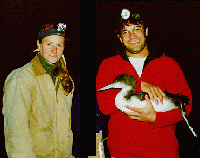Loon Home Page
Challenge Questions

Today's News

Spring's Journey North

Report Your Sightings

Search Journey North
return to:

 A/CPB
A/CPB
Common Loon Migration Update: April 9, 1998
Today's Update Includes:
- Today's Migration News & Data
- A Day in Life of Migrating Loon
- Challenge Questions # 5 & #6
- Eleven Year-Old Loon Returns!
Today's Migration News & Data
The invasion of inland lakes is underway! Loon landings have been reported from 53 sites since our last update:
|
Winter and Breeding Range |
Latest Migration Map |
Following the arrival of the first loon in Madison, Wisconsin on March 26th, Alan Schwoegler has watched loon numbers climb each day:
"On March 28-31 there were only a few (2-3). April 2 there were 5-6 seen. Numbers increased as the weather calmed and 10-15 were seen on April 3-4. Sunday April 5, I toured the lake by boat and had a count of 29 loons. They are coming north fast now."
A Day in Life of Migrating Loon
For a bird that can't walk on land--or take off without a 200-300 meter runway--overland migration presents some challenges. As they fly from the oceans to their nesting grounds on inland lakes, stopover points are critical to loons. Because the Great Lakes are ice-free in early spring, these sites are some of the first places loons appear in the spring. Loons migrate so high and so fast their passage goes almost unnoticed, says author Paul Kerlinger ("How Birds Migrate", Stackpole Books, 1995). According to his estimates, loons migrate 3,000-5,000 feet high and fly with air speeds usually exceeding 40 mph. But with the help of tailwinds they can travel more than 75 mph--and some people estimate as fast as 100 mph!
Challenge Question # 5
If a loon can migrate 10 hours a day at an average speed of 60 mph, how many places would one need to stop between the Gulf coast of Florida and the south shore of Lake Michigan?
Kerlinger's own observations of migrating loons in New Jersey in September revealed a surprising fact: Loons often migrate with their mouths wide open! Any ideas why?
Challenge Question # 6
"Why do you think migrating loons frequently fly with their mouths open?"
(To respond to these Challenge Questions, please follow the instructions at the end of this report.)
Eleven Year-Old Loon Returns!
 Along with the loons, biologists Joe Kaplan and Keren Tischler also flew
back from the wintering grounds last week. Joe checked in with their colleagues at Seney National Wildlife Refuge
on Michigan's Upper Peninsula and heard this exciting news:
Along with the loons, biologists Joe Kaplan and Keren Tischler also flew
back from the wintering grounds last week. Joe checked in with their colleagues at Seney National Wildlife Refuge
on Michigan's Upper Peninsula and heard this exciting news:"The first loon of the season was reported from Seney on April 7. It was a male loon that had been banded as a chick in 1987 --so it is 11 years old.
"This loon has been returning to this refuge for a number of years, but has never held a breeding territory. Last year, following a nest failure of long-established male, this bird took over a pond known as "E-pool". After a considerable amount of courting with the E-pool female (who stayed in the territory) and fighting with another unbanded male, it
looked like this loon may have established himself. Then, the E-pool female appeared disinterested and began wandering the refuge and participating in gatherings with other loons.
"Now that this 'new' male has returned this season to a new territory it should make for interesting drama. The male loon that left the territory last year, following a nest failure, had been on E-pool since at least 1987. We wonder if he will make any effort to regain this territory after holding it for so long? Will he even return? Stay tuned..."
 If the love life of loons at Seney sounds like T.V., it's
because the details of their lives have been more carefully observed there than anywhere on earth. The refuge is
like a laboratory for studying loon behavior. Through concentrated banding efforts --along with careful visual
observations --Kaplan and other biologists are learning important details that have never been known before.
If the love life of loons at Seney sounds like T.V., it's
because the details of their lives have been more carefully observed there than anywhere on earth. The refuge is
like a laboratory for studying loon behavior. Through concentrated banding efforts --along with careful visual
observations --Kaplan and other biologists are learning important details that have never been known before.
How to Respond to Journey North Loon Challenge Questions:
Please answer ONLY ONE question in each e-mail message:
1. Address an e-mail message to: jn-challenge-loon@learner.org
2. In the Subject Line of your message write: Challenge Question # 5 (OR #6)
3. In the body of the EACH message, give your answer to ONE of the questions above.
The Next Loon Migration Update will Be Posted on April 23, 1998.
Copyright 1998 Journey North. All Rights Reserved.




